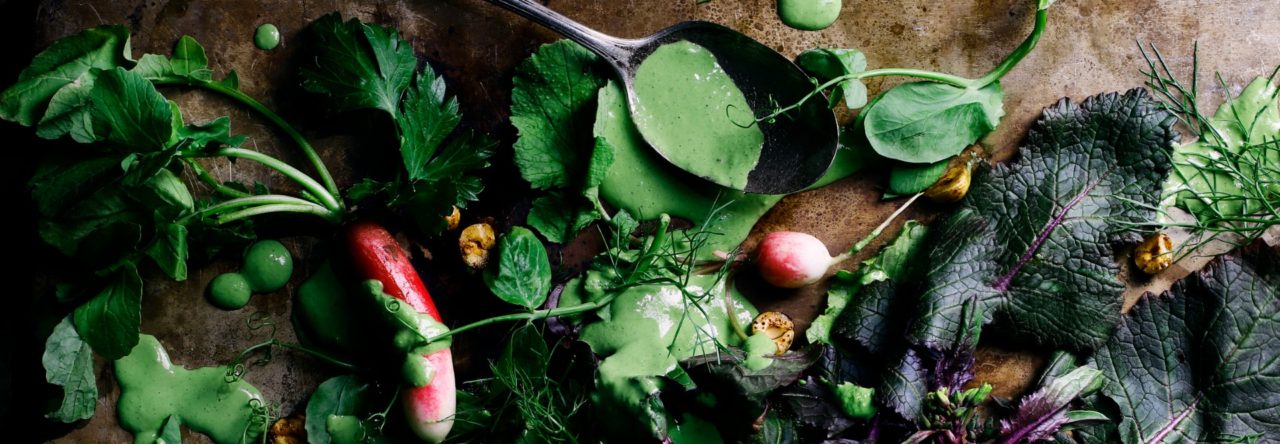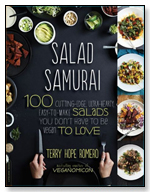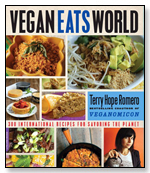
Tamales and Spring. Two great things that are just brilliant together. Consider that tomorrow is Cinco de Mayo–a holiday that you don’t need to be Mexican to appreciate the robust delights of Mexican cuisine–and that we’re now full swing into Spring, and connection becomes clear. Or at least to me it does.
I’m not going to make sweeping assumptions on what you’ll be doing this Thursday, but if you ever lifted a margarita to your lips or enjoyed an plate of enchiladas on the occasional 5th of May it sounds like a perfect time to make tamales, no matter if you’re a seasoned pro with masa harina or never got any closer to tamale crafting beyond peeling away a steamed corn husk.
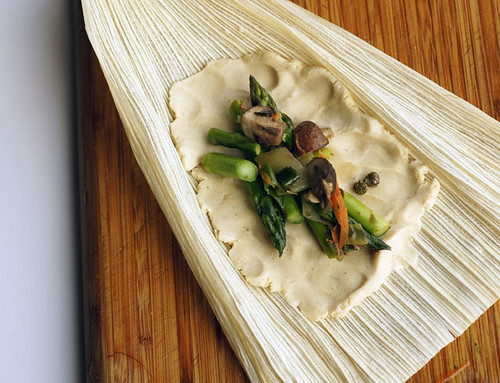
It might be a slightly chilly Spring in NYC, but it’s still the ideal time to seek out those fresh green flavors our palates crave after the heavy richness of winter foods. I haven’t had a chance yet to get down the princess charming of spring vegetables, asparagus, so into the tamales they went. Olive oil enhances asparagus like nothing else, and not since my Veganomicon days have I experimented with an oil-based tamale, so this recipe has Mediterranean bend that just feels so right with the whole spring theme. Note that olive oil gives the masa dough a moist, dense and tender quality unlike the fluffy shortening-based tamales in Viva Vegan!. Any boldly flavored extra virgin olive oil will really sing with the capers, a garnish sometimes found in traditional tamales, so reach for a good quality oil for these guys. Alongside the asparagus lightly cooked mushrooms, leeks and a hint of carrot lend their talents to fill these tender corn dough bundles with fresh spring intentions. Serve with a green tomatillo salsa, either homemade or store bought spiked with a handful of chopped fresh cilantro and you’re on your way to a totally fresh and green tamale fiesta.
As with all tamales these can be assembled a day or two before steaming. Reheat already steamed tamales in the microwave, wrapped in moist paper towels or set once more in the steamer basket for 6-8 minutes until hot in the center. Tamales freeze beautifully too and require just an additional 10 minutes or so of steaming to reheat.
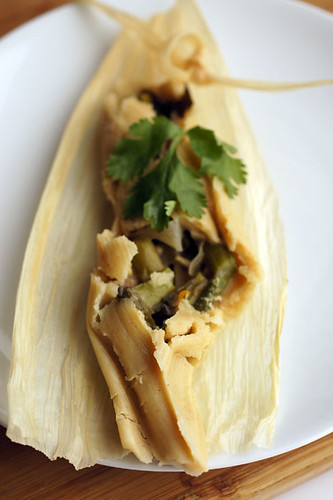
Olive Oil Tamales with Asparagus & Mushrooms
makes 18-20 four inch tamales
Be sure to take a look at these photos for more detailed steps on tamale assembly.
Tip: To freeze olive oil pour into a thin plastic container (like the kind used for takeout soup) and freeze for 1-2 hours until opaque and the consistency of soft sorbet. If the oil becomes too hard let sit on the kitchen counter for a few minutes to soften up.
Tamale tip: Have a bowl of warm water handy when patting out the masa dough; anytime things get sticky dip your fingers in water and continue to pat away.
Masa dough
3 ½ cups Mexican masa harina corn flour
2 teaspoons baking powder
1 ½ teaspoons garlic powder
½ teaspoon sea salt
⅔ cup olive oil, partially frozen
2 ½ cups flavorful vegetable stock, slightly warm (I love vegetarian Vegetable Better Than Bouillon)
Filling
2 tablespoons olive oil
2 cloves garlic, smashed
1 small leek, cleaned and sliced into ¼ inch pieces
3 tablespoons white wine or vegetable broth
10 ounces cremini mushrooms, brushed clean and sliced into quarters
3 tablespoons capers
1 teaspoon dried oregano
½ teaspoon dried rosemary, crumbled
1 small carrot, scrapped and shredded
1/2 pound asparagus, thick end trimmed and sliced into 1 inch pieces
freshly ground black pepper and salt to taste
24 large dried corn husks plus 5 or more additional husks for making ties and lining the steamer
1. Set corn husks to soak in a large baking pan filled with enough hot water to cover and soak until husks are soft and pliable, at least 20 minutes. When husks are soft tear 2-4 husks into strands no thicker than ¼ inch to use for tying ends of the tamale (sort of like a huge wrapped piece of candy). In a large mixing bowl stir together masa harina, baking powder, salt and garlic powder. Spoon in olive oil and use an electric hand mixer to beat until mixture looks sandy. Slowly stream in half of the vegetable broth, continue to beat with the hand mixture and stream in the remaining both until a soft fluffy dough forms. If too dry add a tablespoon of additional broth at a time, if too moist sift in a tablespoon of masa harina. Cover dough tightly with plastic wrap to prevent drying out.
2. Make the filling: Saute in a deep 12 inch skillet over medium heat the olive oil and garlic for 30 seconds until fragrant, then add leek and saute 3-4 minutes until softened, then add wine and deglaze the pan for 30 seconds. Add mushrooms and sweat for 5 minutes, covering half way through to soften mushrooms. Stir in capers, crumbled rosemary, and oregano and remove from heat. Stir in shredded carrot and chopped asparagus, season with pepper and salt and let cool enough to handle.
3. To assemble a tamale spread about 3 heaping tablespoons of dough in the center of large soaked corn husk and pat it into a rectangle shape less slightly more than ¼ inch thick, leaving at least an inch of free space on the husk. If your corn husks are on the small side overlap two or three husks to make one large husk. Spoon 2 heaping tablespoons of filling down the center of the dough, then grab the long ends of each husk and press the dough together to encase the filling. Tuck one side of the husk under the dough to cover it, then wrap the remaining half of the husk around the tamale. Tie both ends of each tamales with a strip of soaked corn husk; it will look a little like a giant piece of wrapped taffy. Repeat with remaining husks and dough. Line the bottom of a large steamer basket with leftover husks and gently stand tamales upright in the basket but don’t pack them in; tamales will expand during steaming and it’s best to make two batches if you can’t fit them all in the steamer at once. Steam for 40-45 minutes until dough is firm (a little like soft, cooled cooked polenta) and easily peels away from a corn husk. Serve hot to guests and let them unwrap their tamales before dipping in salsa or enjoying naked as is.
